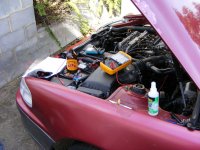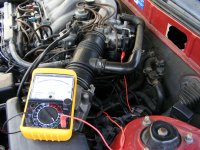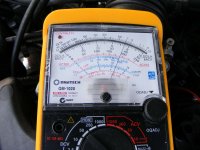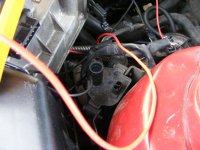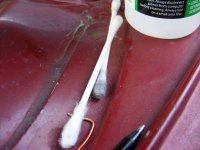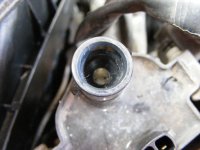If that is the case then tubelab is correct again in predicting the future.
No, just better at remembering almost 50 years of finding ways to break and then fix an automobile.
Up until I got married (and sometimes after that) I would buy a ultra cheap car (free to maybe $250) fix it then drive it until it died, scrap it, repeat. I can remember about 20 cars from age 17 to age 30. Granted it was the days long before fuel injection and ECU's, but the principles remain the same.
In the 80's and early 90's I raced autocross and drag strip with a 1st gen turbocharged fuel injection car (2 cars actually, I wrecked one, stripped it, bought a dead car and installed my powertrain). Trying to extract 200+ HP from a 2.2 L old tech engine and win races against 5.0 L V8 Mustangs teaches you a lot about cars.
The symptoms you describe can be caused by lots of things, including a worn fuel pump. Your car is of the vintage that used a constant flow return system (there is a return line from the injector rails to the gas tank).
The fuel pump must do two things it must make a certain fuel PRESSURE for the injectors to work right, (usually around 50 PSI). This pressure is modulated by engine vacuum such that the RELATIVE pressure drop across the fuel injector remains constant. One end is fed by the fuel pump, the other end sees engine vacuum in the intake manifold.
This means that the ABSOLUTE (relative to ATM) pressure supplied by the fuel pump must increase with engine load. Increased engine load also demands greater fuel FLOW to feed the fire that produces power. It is possible for a worn pump to make enough pressure at idle and low power but not be able to meet the increased pressure demands at the higher flow rate demanded by an up hill climb. Increased internal pump clearances caused by wear are to blame.
The fuel pump uses brushes and a commutator like those found in an electric drill. These are wear items and have a nasty habit of dying without warning at EOL. If this car is to be relied on for daily driving, a new fuel pump is a good investment especially when the old one has a zillion miles on it. Pushing a dead car almost a mile and paying for the subsequent repair taught me that one.
Stale fuel, fuel that has been in the tank for a long time will lose octane rating. Some of the more volatile compounds will evaporate and others will settle out. This can cause a car to lose power, or knock, setting off the knock sensor, which will further reduce power. Fuel stabilizer helps, but it won't extend fuel life forever. Some brands make matters worse (cause knock) once the stabilizer itself begins to break down.
I don't know if Aussie fuel has ethanol blended into it, but that makes matters worse. Alcohol will absorb water from the air (so will gasoline to a lesser extent) and settle out in the fuel tank. It remains on the bottom of the tank in little round beads that get sucked up and fed to the engine. This was a real problem on older cars with a vented tank in the humid air of Florida.
I have seen a bad ignition coil cause similar problems. Again granted it was a points ignition 1960's car, but the science is the same.......
Lets assume for simple math that a car engine has a 10:1 compression ratio. This means that the cylinder fills with fuel/air mix during the intake stroke which is then squeezed into a space 1/10 it's volume during the compression stroke. At the moment of ignition there can be 10 times as many molecules of fuel/air stuffed into that 1 mm spark plug gap as there was during intake. This makes the real plug gap more like 10 mm........In reality the cylinder is drawing from an intake manifold under vacuum with only a small amount of fuel present at idle, so the apparent gap is still small, maybe a few mm. Under full throttle the cylinder is drawing from an intake manifold with near zero vacuum and full of non conductive fuel mist which is a better insulator than air. This makes the apparent plug gap more like 20 mm. A wimpy coil may not fully ignite the mixture, or may not ignite it at all.......wait, there's more in a newer car!
This unburned fuel/air mix is full of OXYGEN. The extra oxygen in the exhaust then convinces the O2 sensor (senses O2, not fuel) that the car is running lean, so the ECU responds by turning up the fuel flow. The extra fuel makes the mixture harder to ignite, and makes less power when it does ignite, so an avalanche effect occurs and the car just dies!
Thanks for the explanation of how an aging fuel pump could cause the issue described! I should have used my brain a bit more 
Venusfly, if it still doesn't fix it, at least you have a few more possible culprits to consider now with tubelab's and my posts
Also the over-fueling due to a bad coil and the explanation as to why is great as well!
Tony.
Venusfly, if it still doesn't fix it, at least you have a few more possible culprits to consider now with tubelab's and my posts
Also the over-fueling due to a bad coil and the explanation as to why is great as well!
Tony.
Last edited:
I can think of one thing that may be a problem (assuming your car has one) and that is the throttle position sensor.
( I think I killed it when I used throttle body cleaner)!
yep I've got a throttle position sensor and I remember going through all of that with throttle body cleaner a long long time ago. Could be my problem right there. Mine doesn't show erratic idle though. Only when the car is warmed up and has been running for a while and then when I put it under load does it decide to misfire and stall. Also whenever I blip the throttle the car responds in kind all the way up to 5 grand. only does it act up when its under heavy load, aka, hillclimb.
There is an old hose on the IAC valve (idle air control booster hose) but I've never suspected that hose because the idle has always been rock solid (you could set your watch to the idle quality that this engine makes). I WILL replace this hose on monday though, it shouldn't be that expensive.
So what will get replaced on monday:
fuel pump
fuel
IAC vacuum booster hose.
front brake pads.
I've got plenty of Deoxit Fader F5 left so if that still doesn't fix things I can remove the TPS and spray that but I might want to leave that sleeping dog lie you know...
As tubelab has mentioned, only problem I'm experiencing right now is a gross misfire and a stall and lack of power when going up a hill which points me to the fuel pump, which has 356,000km on it.... so yeah, as he also said, a good investment. Car runs like a Casio whenever its doing anything else right now on the flats.
And yes, in regards to ethanol. We do have it here but I activley avoid it. I always fill up with 91-95-98 (usually 95) that is ethanol free.
Last edited:
Idle should have low manifold pressure, so even if the map sensor is not working properly it may idle reasonably (My car wont if I disconnect the hose to the MAP sensor though).
I believe a faulty one will result in under-fueling under higher engine load. A vacuum leak in the hose to the MAP sensor will give similar issues.
Tony.
I believe a faulty one will result in under-fueling under higher engine load. A vacuum leak in the hose to the MAP sensor will give similar issues.
Tony.
This engine has an AFM. Air flow meter. no MAP sensor and no MAF meter.
TOYOTA 3VZ–FE TROUBLESHOOTING MANUAL Pdf Download.
It doesn't even have an electric cooling fan, it has an electrically actuated hydraulic cooling fan mounted to the radiator which is driven by hydraulic pressure from the power steering pump (power steering pump is actually two pumps sandwiched one to the other driven by the same shaft, one provides hydraulic pressure to the steering rack, the other to the fan, quite fuel efficient when you think about it.)
Here is some light reading 528 pages worth.
528 pages worth.
TOYOTA 3VZ–FE TROUBLESHOOTING MANUAL Pdf Download.
It doesn't even have an electric cooling fan, it has an electrically actuated hydraulic cooling fan mounted to the radiator which is driven by hydraulic pressure from the power steering pump (power steering pump is actually two pumps sandwiched one to the other driven by the same shaft, one provides hydraulic pressure to the steering rack, the other to the fan, quite fuel efficient when you think about it.)
Here is some light reading
Last edited:
I'm thinking you may have hit the nail on the head with the TPS. I'll leave that to last I think though because the car runs fine on the flat but it does run rough and almost stall when I hit the brakes hard even on the flat. It is otherwise driving like a stabbed rat when on the flats. So the fuel pump is still suspect.
Watch Out! Here are the Symptoms of a Bad Throttle Position Sensor
Don't think I've ever experienced hesitation while in this car, misfires yes. hesitation. no.
Bucking and jerking motion while accelerating, hell no, accelerates amazingly smoothly when its not misfiring.
Idle surging, no.
Sudden stalling, yes. But random stalling has disappered since I replaced the O2 sensors and the ECT sensor.
Difficulty while changing gears, no.
Symptoms of a Bad or Failing Throttle Position Sensor
accelerates itself... yeah a LONG time ago it did it once and I told my mechanic about this and it never happened again, but I blamed it on a stuck throttle cable, which I WAS fiddling with earlier that day. never did it again.
engine wont idle smoothly, hell no. rock solid idle.
car accelerates but won't exceed a relativley low speed, or shift up. nope. shifts up just fine and goes to 60-80km/h just fine when its not misfiring.
Watch Out! Here are the Symptoms of a Bad Throttle Position Sensor
Don't think I've ever experienced hesitation while in this car, misfires yes. hesitation. no.
Bucking and jerking motion while accelerating, hell no, accelerates amazingly smoothly when its not misfiring.
Idle surging, no.
Sudden stalling, yes. But random stalling has disappered since I replaced the O2 sensors and the ECT sensor.
Difficulty while changing gears, no.
Symptoms of a Bad or Failing Throttle Position Sensor
accelerates itself... yeah a LONG time ago it did it once and I told my mechanic about this and it never happened again, but I blamed it on a stuck throttle cable, which I WAS fiddling with earlier that day. never did it again.
engine wont idle smoothly, hell no. rock solid idle.
car accelerates but won't exceed a relativley low speed, or shift up. nope. shifts up just fine and goes to 60-80km/h just fine when its not misfiring.
Last edited:
..... only problem I'm experiencing right now is a gross misfire and a stall and lack of power when going up a hill which points me to the fuel pump, which has 356,000km on it .....
Going up a hill is putting the engine under a high load.
My experience with fuel pumps and pressurized fuel injection systems, is that they are all or nothing affairs. Either the pump can pressurize the rail sufficient for normal operation, or it can't. No in between. The only intermittent operation I have seen is that a failing pump can refuse to work when hot, but work for a while after it cools down. You can disconnect the fuel line, pressurize the pump, and be amazed at how far it can squirt fuel yet still have insufficient force to pressurize the injectors.
Get a fuel pressure gauge and check the pressure before you replace the pump.
My WAG: I would consider the possibility that all the fuel that has been pumped into the cats began to plug them up if it did not get burned off. High back pressure in the exhaust is worth considering and can manifest itself with the type of behavior you describe under high load.
One of my businesses is a gas station. I have kept fuel for my own personal use in a UST for over a year without problems. Lab analysis might show a degradation, but the cars couldn't tell. I don't have slug cars ( Jaguars and Pontiacs ). I have also kept fuel in farm tanks without issue. I don't bother with stuff like Stabil. I haven't ran my Solstice since my son was born ( six years - may wind up as a 1000 mile ish new car find for someone when I croak ). I expect it will start just fine when the battery is reinstalled, but will need fresh gas at that age for full performance.
It takes really bad fuel to stop a modern car. It will smell like varnish when it gets to that point. Or it will be adulterated with a foreign contaminant that you can observe as layers in a sample.
Win W5JAG
If it turns out to be the ignition coil and/or ignition control module it wouldn't be too expensive to replace both:
TRIDON IGNITION COIL FOR Toyota Camry-V6 VCV (Vienta) 10/95-9/97,V6,3.0L 3VZ-FE | eBay
IGNITION MODULE for TOYOTA VIENTA VCV10R 3.0L V6 FWD [08/94 - 07/97] | eBay
TRIDON IGNITION COIL FOR Toyota Camry-V6 VCV (Vienta) 10/95-9/97,V6,3.0L 3VZ-FE | eBay
IGNITION MODULE for TOYOTA VIENTA VCV10R 3.0L V6 FWD [08/94 - 07/97] | eBay
Get a fuel pressure gauge and check the pressure before you replace the pump.
I've had enough of buying tools that I'll only ever use once
I could buy a cheap Kemso fuel pump for the price of a fuel pressure tester:
Fuel Pressure Meter Tester Oil Combustion Spraying Injection Gauge Car 788537801429 | eBay
KEMSO 340LPH High Flow Fuel Pump Toyota SDV10 VDV10 SXV10 MVC20 CAMRY VIENTA 738770663681 | eBay
Might just end up doing that and keeping the money spent buying a $200 Denso fuel pump at Bursons to buy the ignition module and ignition coil off ebay.
Denso off ebay is $90: Fuel pump for Toyota SDV10 VDV10 SXV10 MVC20 CAMRY VIENTA Intank Genuine DENSO | eBay
Only reason why I don't is because I'm weary of fakes but if the seller has been on ebay since 2002... ehhhh I guess I could trust my life and the life of my family to that descision. I mean I could always buy a spare at this price later on.
Only other cause is the ignition coil and if the ignition coil is bad then why can the car run at all when the computer was dumping fuel into the engine when the ECT/engine coolant temperature sensor was faulty. Wouldn't the weak spark then be blown out by the fuel? When there was literally fuel coming out of the tailpipe....
I could check spark strength and ignition coil resistance and compare it with my service manual.
It revs fine right up to 5,000 rpm when its in the driveway. Doesn't make sense, it wouldn't rev that high if it was a plugged cat and it wouldn't go like a stabbed rat when the car is on the flat roads, I've also done acceleration tests before and its right on factory spec at 8.2 seconds for the 0-60 mph acceleration test (M/T is 7.2). Also checked the cat at least 3 times to see if it was glowing red hot on the day that I started the car up and let it come up to operating temperature both before and after taking the car for its test drive, it was never glowing red hot even when there was fuel coming out the tailpipe.High back pressure in the exhaust is worth considering and can manifest itself with the type of behavior you describe under high load.
Yeah mine didn't smell like varnish, it just had a yellowish tinge to it, also left an orange residue in the glass jar after it was left out in the sun all day yesterday and turned orange. When it was pumped from the gas tank in my car it was only slightly yellow though, like really watered down tang.It takes really bad fuel to stop a modern car. It will smell like varnish when it gets to that point.
Thanks for your input!
Anyway all of this thinking is giving me a headache, I would much rather prefer the caveman approach of replacing parts. Only slightly kidding there too.
Last edited:
Only other cause is the ignition coil and if the ignition coil is bad then why can the car run at all when the computer was dumping fuel into the engine when the ECT/engine coolant temperature sensor was faulty. Wouldn't the weak spark then be blown out by the fuel? When there was literally fuel coming out of the tailpipe....
I think you need to re-read this
I have seen a bad ignition coil cause similar problems. Again granted it was a points ignition 1960's car, but the science is the same.......
Lets assume for simple math that a car engine has a 10:1 compression ratio. This means that the cylinder fills with fuel/air mix during the intake stroke which is then squeezed into a space 1/10 it's volume during the compression stroke. At the moment of ignition there can be 10 times as many molecules of fuel/air stuffed into that 1 mm spark plug gap as there was during intake. This makes the real plug gap more like 10 mm........In reality the cylinder is drawing from an intake manifold under vacuum with only a small amount of fuel present at idle, so the apparent gap is still small, maybe a few mm. Under full throttle the cylinder is drawing from an intake manifold with near zero vacuum and full of non conductive fuel mist which is a better insulator than air. This makes the apparent plug gap more like 20 mm. A wimpy coil may not fully ignite the mixture, or may not ignite it at all.......wait, there's more in a newer car!
This unburned fuel/air mix is full of OXYGEN. The extra oxygen in the exhaust then convinces the O2 sensor (senses O2, not fuel) that the car is running lean, so the ECU responds by turning up the fuel flow. The extra fuel makes the mixture harder to ignite, and makes less power when it does ignite, so an avalanche effect occurs and the car just dies!
My experience with fuel pumps and pressurized fuel injection systems, is that they are all or nothing affairs.
I had a 1989 Eagle Summit (a Mitsubishi Mirage in Jeep / Eagle trim) that would run OK around town but start to run poorly at I-95 speeds. It could hit 85 MPH tops at the start of my commute, but after an hour at 60 to 70 the pedal was on the floor to keep up with traffic. The car gave no fault codes nor could the dealer find any issue. It kept getting worse until one day it just wouldn't start. Autopsy revealed no fuel pressure. After getting the assembly out of the tank and finding out that a new one was over $300 in 1992 dollars, I decided to autopsy the fuel pump. The in tank pump made no noise and drew no current when powered up in the tank.
DANGER!!!!!WARNING!!!!!!!RISK OF FIRE.....A fuel pump contains a DC motor that has brushes. These brushes are normally submerged in and lubricated by gasoline.....YES Sparking brushes running in gasoline!!!!!! Inside the fuel tank there is no air. No oxygen, no BOOM. Take the pump out of the tank and try to power it up and you could have a big mess on your hands and maybe some burnt hands or worse. DON'T DO THIS!!!!!!
After leaving the dead pump in the hot sun for most of the day I decided that I could poke around the assembly outdoors with an ohmmeter connected in series with a 10K resistor to limit current but test for continuity. The path for power from the outside world through the bulkhead assembly into the tank was a lug on either side of the plastic connected by a rivet. This connection was open and looked a bit melted where it had obviously been hot. This was on the gas tank mounted under the rear seat. I hacked out the rivet with a pair of wire cutters and replaced it with a #6 screw, nut and pait of star washers.......All was well and the free repair lasted until I traded the car in.
Yes, this was an unusual case, but the turbo racers often talked of frying parts under boost due to weak fuel pumps. Truth or Fiction, I don't know. I got the prescribed part Carroll Shelby told me to use from Chrysler's Direct Connection program and never had a problem with it.
Is the fuel pump his problem? Maybe, maybe not, but with 221,000 miles over about 20 years, I would be changing it, the brushes are probably nubs being pushed by weak springs.
I think you need to re-read this
Yeah but its no longer dumping fuel in the tailpipe. In fact as soon as I drove it aorund for a while on the lets just call it the "test day" the problem of excessive fuel consumption disappered and the unburnt fuel in the tailpipe gradually went away the more I ran the car.
That was after I replaced the O2 sensors and the ECT on the 13th of this month.
The only problem I'm getting now is a misfire/lack of power when going up hills, everything else is fine.
Last edited:
BUT
We can test the ignition coil! with the service manual and a digital multimeter.
We can also test the throttle position sensor for any dead spots/and or any shuddering in the readings on the DMM.
And that is what I intend on doing today.
I'm also going to clean the insulator tower on the ignition coil with a q tip and some isoprop.
We can test the ignition coil! with the service manual and a digital multimeter.
We can also test the throttle position sensor for any dead spots/and or any shuddering in the readings on the DMM.
And that is what I intend on doing today.
I'm also going to clean the insulator tower on the ignition coil with a q tip and some isoprop.
Ignition coil is within spec according to my DMM.
0.3 ohms on the primary winding side (factory specs are 0.2-0.3 ohms)
8.54k ohms on the secondary. (factory specs are 6-13k ohms)
Cleaned the insulating tower and got a lot of gunk/dust buildup out of it as can be seen from the evidence left on the Q-Tip.
Inspected the throttle position sensor but I didn't do the test properly (engine needs to be running or I need to produce a source of vacuum to do the test properly). I just inspected it for any dead spots with an analog and digital multimeter, none were found, and all measurements were within tolerance of what it says on the specs sheet. No "jitteryness" was found either, readings were smooth as butter.
Fuel pump replacement time?
0.3 ohms on the primary winding side (factory specs are 0.2-0.3 ohms)
8.54k ohms on the secondary. (factory specs are 6-13k ohms)
Cleaned the insulating tower and got a lot of gunk/dust buildup out of it as can be seen from the evidence left on the Q-Tip.
Inspected the throttle position sensor but I didn't do the test properly (engine needs to be running or I need to produce a source of vacuum to do the test properly). I just inspected it for any dead spots with an analog and digital multimeter, none were found, and all measurements were within tolerance of what it says on the specs sheet. No "jitteryness" was found either, readings were smooth as butter.
Fuel pump replacement time?

Attachments
Last edited:
Hokay what did we learn today.
Service manual says the fuel pump resistance should measure between 0.2 and 3.0 ohms.
Fuel pump actual reading is 2.5 ohms.
Also done a current draw test on the fuel pump with (A Destructive test >>>a bucket of water<<< A Destructive test) and a small SLA battery. Made the connection on the battery side and used my good alligator clip leads.
Maximum Current draw when the output of the fuel pump was pinched with a pair of pliers, no leaks, was 5.6 amps.
Free running on air current draw was 1.0 amps.
I think this fuel pump is rated for 6 amps maximum but I'm not 100% sure.
What does this information tell us?
Well the high resistance reading tells me that the fuel pump's brushes are probably worn.
But the high amperage draw when the output was blocked off with a pair of pliers tells me that the fuel pump is okay and is capable of producing a large amount of pressure.
But if the brushes are on their last legs then it COULD conceivably produce the problem symptom which I have which is that the car misfires suddenly and randomly or whenever the engine is under a heavy load ie going up a hill. if the commutator brushes aren't making contact all of the time then I can see them making an intermittent fuel delivery problem and that is exactly what I'm experiencing.
Using these videos as a guide:
YouTube
Service manual says the fuel pump resistance should measure between 0.2 and 3.0 ohms.
Fuel pump actual reading is 2.5 ohms.
Also done a current draw test on the fuel pump with (A Destructive test >>>a bucket of water<<< A Destructive test) and a small SLA battery. Made the connection on the battery side and used my good alligator clip leads.
Maximum Current draw when the output of the fuel pump was pinched with a pair of pliers, no leaks, was 5.6 amps.
Free running on air current draw was 1.0 amps.
I think this fuel pump is rated for 6 amps maximum but I'm not 100% sure.
What does this information tell us?
Well the high resistance reading tells me that the fuel pump's brushes are probably worn.
But the high amperage draw when the output was blocked off with a pair of pliers tells me that the fuel pump is okay and is capable of producing a large amount of pressure.
But if the brushes are on their last legs then it COULD conceivably produce the problem symptom which I have which is that the car misfires suddenly and randomly or whenever the engine is under a heavy load ie going up a hill. if the commutator brushes aren't making contact all of the time then I can see them making an intermittent fuel delivery problem and that is exactly what I'm experiencing.
Using these videos as a guide:
YouTube
Last edited:
.... What does this information tell us? Well the high resistance reading tells me that the fuel pump's brushes are probably worn.
If the conductive path is through the carbon brush, doesn't it suggest that the brush is not worn down or the high resistance is elsewhere? i.e. short brush should be less resistance, since there is less material to resist?
Assuming a DMM is trustworthy at measuring these very low resistances. I don't know the answer to that.
Since this is an in tank pump, and you already have the stuff out of the tank ( do you have to drop the tank? ), I guess the correct call is to replace it. I'm not going to argue against replacing an aged pump that may very well be on it's way out.
I don't know about Australian aftermarket car parts, although I guess I will find out as my G8 ages out. Around here, the aftermarket parts from the usual chain stores for normal cars like Ford, GM, etc., can be sketchy. They can test the parts as "good" in their store, but when you put them on the vehicle, they are not serviceable, so you have to replace them multiple times. I've had this happen with starters, alternators, a/c compressors, and fuel pumps. Fortunately for my knuckles and temper that was a frame mounted fuel pump. It may be worth the money to get an OEM pump.
My Jaguar V12 has two fuel pumps, at full throttle it can't gobble premium fast enough on only one pump, so a second one kicks in. This can also serve as a reserve if the primary fails - just pull the relay and put a jumper across the contacts to turn on the second pump. So a bad pump never strands you in the middle of nowhere .....
Win W5JAG
On the topic of troubleshooting electric motors in cars, I had trouble with my Contour's heater for years.
I'm a controls engineer, at least was years ago, so I kept thinking in industrial troubleshooting terms, which is: if an electric motor turns, then it is good, intermittency lies elsewhere.
It was only when I googled and found a thread where someone pointed that an electric motor in a car environment could be intermittent because worn brushes could be vibrated back into proper position by driving. Aha, that was it, problem fixed for good when pick n pull had their next 50% sale. My $0.02
I'm a controls engineer, at least was years ago, so I kept thinking in industrial troubleshooting terms, which is: if an electric motor turns, then it is good, intermittency lies elsewhere.
It was only when I googled and found a thread where someone pointed that an electric motor in a car environment could be intermittent because worn brushes could be vibrated back into proper position by driving. Aha, that was it, problem fixed for good when pick n pull had their next 50% sale. My $0.02
.... worn brushes could be vibrated back into proper position ....
I thought the technical term for this was "impact adjustment"? Starter motors in particular .....
Win W5JAG
edit: I guess I will toss in a rant / whine about the good old days, not that long ago, when the amateur could just take apart a window lift motor, alternator, etc., and go down to the hardware store and rummage through a box of brushes to find some that fit.
Last edited:
- Home
- Member Areas
- The Lounge
- The car thread
